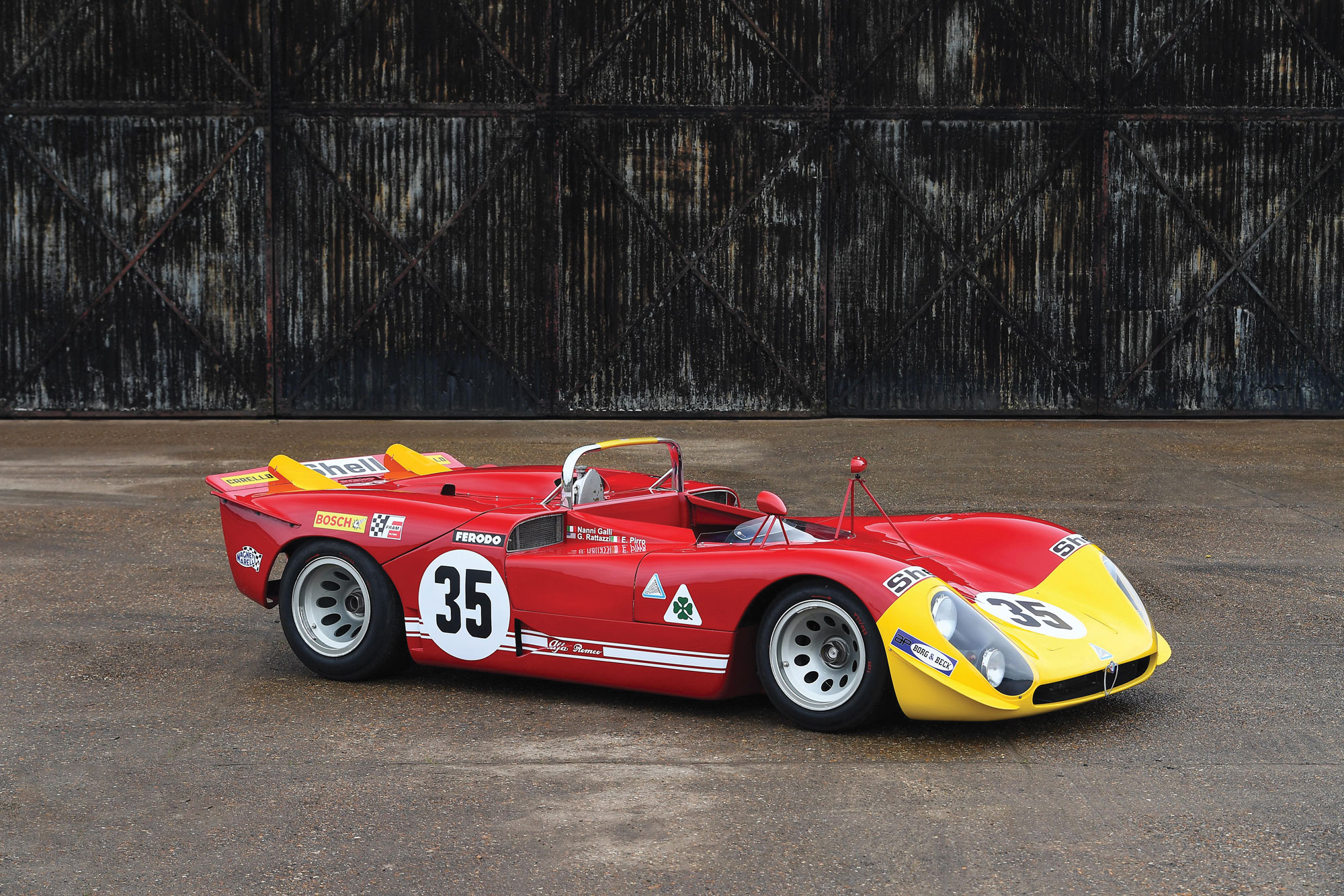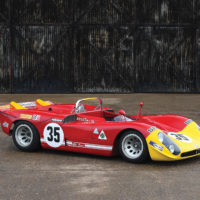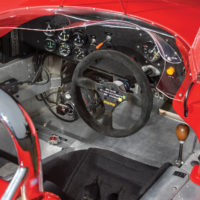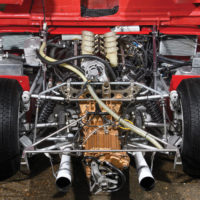SCM Analysis
Detailing
| Vehicle: | 1969 Alfa Romeo Tipo 33/3 |
| Years Produced: | 1969–70 |
| Number Produced: | 22 |
| Chassis Number Location: | Plate in cabin |
| Engine Number Location: | Block at left cylinder head |
| Club Info: | Alfa Romeo Owners Club |
| Website: | http://www.aroc-usa.org |
| Alternatives: | 1971 Ferrari 312 PB 1967–71 Porsche 908 1969–71 Matra MS650 |
This car, Lot 146, sold for $1,699,246 (€1,636,250), including buyer’s premium, at the RM Sotheby’s Monaco auction on May 14, 2022.
The history of Alfa Romeo’s Tipo 33 racers has most of the characteristics of an Italian opera about Don Quixote. These cars are thrilling, epic, filled with grand expectations and make fabulous sounds. But they are also disappointing, frustrating and often wildly complex, with the final triumph held to the last act after most of the audience had stopped caring.
The pool of buyers for racers like these is thus limited to people who are both cognoscenti and Alfisti. These are highly knowledgeable and passionate individuals who have bought into the Alfa Romeo mythology — drunk the Kool-Aid, if you will — and are thus willing to endure the frustrations and challenges of owning them in exchange for the thrilling glimpses of genius and occasional triumph that they afford.
A tortured racing career
The FIA Manufacturer World Championships of the era were owned first by Porsche with exquisite engineering and reliability (and a 5.0-liter displacement exemption for the 917, but that is a different story). Next by Ferrari, with a Formula One approach to complexity and budget. Finally, Matra brought its relentless determination and development. Through the whole thing, Alfa fielded excellent, innovative, exciting and beautiful racers that, through a combination of bad luck, bad timing, and only occasional brilliant finishes, were relegated to secondary importance behind battles of giants.
In the early 1970s, the Arab oil crisis cast a pall over motorsports, with questions of relevance, declining attendance and industrywide financial stress. Still, Alfa soldiered on, creating ever-more-evolved Tipo 33 variants as the brand struggled. In early 1975, Alfa threw up its hands and accepted that it couldn’t afford to continue. It turned over management of the entire team to a wealthy Austrian and, of course, that team finally won the World Championship.
By then, though, racing had moved on and nobody much cared. The curtain came down in triumph as the orchestra stopped playing. It was over. Alfa sat out 1976 before winning again in 1977, mostly because there was no competition.
For most of its history, then, the Alfa Tipo 33 was the proverbial bridesmaid, a beautiful, exciting, and somewhat erratic accessory to the main show. It is still important, though, so let’s talk about the details.
Big considerations
The first thing to remember about Tipo 33s is that there was no production line. They were all hand-built by Autodelta (the Alfa racing shop) as factory team racers, never sold new to a customer. This means that every T33 has factory team history, which is good. But it also means that because they were built individually as a constantly evolving series, no two are exactly alike; each was effectively a one-off. Fifty years later, this can create headaches in terms of finding replacement parts to keep a car racing.
The second thing to keep in mind, particularly if you want to want to race one, is that they were notoriously unreliable. Alfa’s history of the period is filled with DNFs, mostly due to engine failure. It had great aspirations, but with a limited engineering and development budget, the results were predictable. When Alfa finally got the 2.0-liter V8 working right, it moved to a 3.0-liter V8. When it finally got that sorted and reliable, it moved to a flat-12. The good news is that today we have access to developed, reliable versions of each engine.
The opera unfolds
The first 1967 T33 was a nifty little 2.0-liter V8 designed to run against Porsche’s 910. It was a light, low-drag car with excellent handling, but unfortunately, it was too fragile for bumpy road courses like the Targa Florio. The engine made 270 hp at 9,600 rpm, but barely ran under 7,500 rpm, and at about 10,200 rpm, they went bang. This required a 6-speed transaxle and skilled drivers to keep the flame lit without failures.
Porsche’s 906 and 910 were robust, forgiving and easy to drive, so the T33 struggled. Alfa did manage to sweep the 2.0-liter class at Le Mans in 1968, finishing 4th through 6th overall, but finished the year a distant 3rd in points.
Beginning in 1969, the FIA set the World Championship series for 3.0-liter prototypes running as Group 6, which allowed smaller automakers, such as Porsche, Matra and Alfa Romeo, to compete for overall wins. In anticipation, Autodelta created an essentially new car, our subject Tipo 33/3. It used a new 3.0-liter V8 engine with 440 hp and a decent torque curve, a 5-speed transaxle and a new monocoque chassis.
Alfa entered the season with high hopes, only to have them crumble almost immediately. The Tipo 33/3’s Sebring 12-hour debut was a complete catastrophe, with all three cars out of the race in the first hour. It was worse than that, though, as Alfa realized it had brought a knife to a gunfight.
The problem was that the FIA, worried that it wouldn’t get enough Group 6 entrants to put on a show, had expanded the Championship entry to include Group 4. Its intent was to allow relics from previous seasons like the Lola T70 and Porsche 910 to fill up the starting grids. It set a minimum production of 25 cars and 5.0-liter displacement to accomplish the end. This was a great idea until Porsche realized that if it built 25 brand-new racers, it could use a 5.0-liter engine. Thus, the 917 was born and the racing world was upended. Ferrari was able to counter with its 512 S, but Alfa was stuck with a 3.0-liter car in a 5.0-liter world.
Having never built a racer over 3.0 liters, Alfa was not about to start. Moreover, the rules allowing Group 4 entries were to expire with the 1971 season, so the team gamely soldiered on, concentrating on races where 3.0-liter cars had their own class or could effectively compete. 1970 was a tough year for the Tipo 33/3, but by 1971 Alfa had gotten it developed to the point where it was competitive against Porsche’s 908 and Matra’s MS650. In the last year of the 917, the championship belonged to Porsche, but the Tipo 33/3s finished a strong 2nd, impressive considering they were giving away two whole liters of displacement.
In 1972, the first year of a true 3.0-liter championship, Alfa was ready with an upgraded, shorter, lighter, tube-framed Tipo 33TT/3. But Ferrari had its 312 PB, effectively a Formula One car with full bodywork, so Alfa went back to playing bridesmaid.
An Alfisti’s prize
From the standpoint of either a collector or a vintage racer, the Alfa T33s are all better suited to the Alfisti than to a pragmatic player. Porsches are easier to own, easier to drive, easier to find parts for, easier to win with, and easier to sell when the time comes. On the other hand, Alfas are opera stars. They can be demanding, finicky and frustrating as well as exciting, seductive and extremely quick. They have huge personalities and quirks that owners and drivers must adapt to. This limits the market and holds values well below comparable racers from Ferrari and Porsche.
For a true believer, though, racing cars don’t get much better. This Alfa was fairly bought and sold. ♦
(Introductory description courtesy of RM Sotheby’s.)



